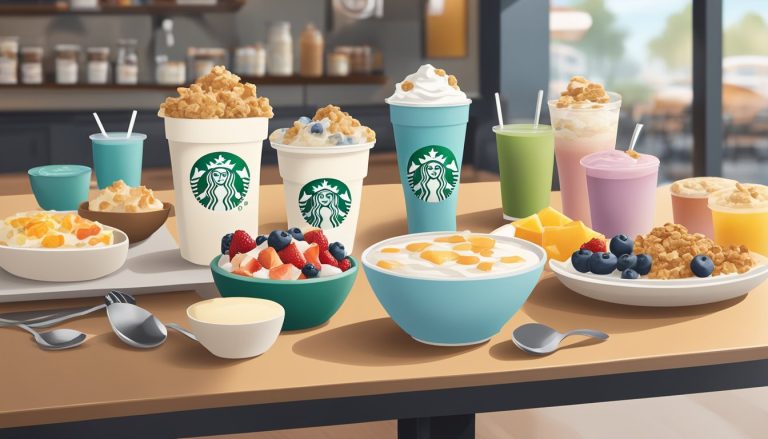Starbucks, the global coffee giant, continually innovates its menu to keep customers excited and engaged. The company’s product development team works tirelessly behind the scenes to create new breakfast items that satisfy diverse tastes and dietary preferences.
Starbucks’ breakfast item development process involves market research, ingredient sourcing, taste testing, and nutritional analysis. The team draws inspiration from popular food trends, customer feedback, and seasonal flavors to craft unique offerings. They collaborate with suppliers to source high-quality ingredients and experiment with various combinations to achieve the perfect balance of taste and texture.
The company’s commitment to innovation extends beyond traditional coffee-based products. Starbucks has expanded its breakfast menu to include protein-packed options, plant-based alternatives, and culturally inspired dishes. This approach helps Starbucks cater to changing consumer preferences and maintain its position as a leader in the competitive breakfast market.
The Starbucks Experience

Starbucks has redefined coffee consumption by creating a unique, immersive experience for customers. The company focuses on fostering a welcoming environment and building strong connections with patrons.
The Concept of ‘Third Place’
Starbucks positions itself as a ‘third place’ between home and work. This concept aims to provide a comfortable space where people can relax, socialize, or work. Stores feature cozy seating, warm lighting, and inviting decor to create a welcoming atmosphere.
Baristas are trained to engage with customers, remembering names and preferences. This personal touch enhances the overall experience and keeps patrons coming back.
Music plays a crucial role in setting the mood. Carefully curated playlists complement the ambiance and reflect local tastes.
Customer Engagement and Loyalty
The Starbucks Rewards program is a cornerstone of customer engagement. Members earn ‘Stars’ for purchases, redeemable for free items. This system encourages repeat visits and brand loyalty.
The Starbucks mobile app revolutionized the coffee-buying experience. Launched in 2009, it allows customers to order ahead, pay, and customize drinks effortlessly.
In-store events, such as coffee tastings and local artist showcases, foster community connections. These activities reinforce Starbucks’ role as a gathering place beyond just serving coffee.
Seasonal promotions and limited-time offerings create excitement and drive foot traffic. The company’s ability to adapt to local tastes while maintaining brand consistency contributes to its global appeal.
Product Development Process

Starbucks employs a multi-faceted approach to develop new breakfast items. This process involves gathering customer input, leveraging internal expertise, and rigorously testing products before launch.
Ideation and Feedback
Starbucks initiates product development by identifying customer needs and preferences. The company analyzes market trends, sales data, and customer feedback to generate ideas for new breakfast offerings.
Food scientists and culinary experts at Starbucks then brainstorm concepts, considering factors like taste, nutritional value, and scalability. They create prototypes and conduct internal taste tests to refine recipes.
Customer feedback plays a crucial role in this stage. Starbucks often surveys loyal customers and rewards program members to gauge interest in potential new items.
Collaboration and Crowdsourcing
Starbucks embraces collaboration and open innovation in its product development process. The company partners with food suppliers, nutritionists, and sometimes even celebrity chefs to create unique breakfast offerings.
The “My Starbucks Idea” platform allows customers to submit product suggestions directly. This crowdsourcing initiative has led to the creation of popular items like the Sous Vide Egg Bites.
Cross-functional teams within Starbucks work together to ensure new products align with brand standards, operational capabilities, and sustainability goals.
Trial and Introduction to Market
Before widespread release, Starbucks tests new breakfast items in select markets. This allows the company to gather real-world feedback and make necessary adjustments.
The company carefully monitors sales data, customer reactions, and operational impacts during these trials. Successful items may undergo further refinement based on this feedback.
Starbucks then develops a rollout strategy for promising products. This includes training baristas, updating menu boards, and creating marketing campaigns to introduce the new breakfast items to customers nationwide.
Sustainability and Social Responsibility

Starbucks has made sustainability and social responsibility key pillars of its business model. The company focuses on ethical sourcing practices and implementing environmental initiatives to reduce its ecological footprint.
Sourcing and Ingredients
Starbucks prioritizes responsible sourcing for its breakfast items and other products. The company works directly with farmers through its nine Farmer Support Centers located in coffee-producing countries. These centers provide resources and expertise to help growers implement sustainable farming practices.
For breakfast ingredients, Starbucks aims to use:
- Cage-free eggs
- Responsibly sourced cocoa
- Milk from cows not treated with rBST
The company has also committed to increasing plant-based options on its menu to reduce environmental impact. This includes offering oat, almond, and soy milk alternatives.
Environmental Initiatives
Starbucks has set ambitious goals to minimize waste and reduce its carbon footprint. Key initiatives include:
- Developing more sustainable cold cups with 20% less plastic
- Installing electric vehicle chargers at stores along a 1,400-mile route
- Implementing a “Greener Stores” framework to build and operate environmentally friendly locations
The company aims to give more than it takes from the planet. Starbucks is testing innovative solutions to support partners, farmers, and communities facing climate change challenges. This includes a traceability pilot project to ensure the future of high-quality coffee production.
Innovation in Menu Offerings

Starbucks continuously expands its menu with creative new items to meet evolving customer tastes. The company focuses on plant-based options and seasonal specialties to keep offerings fresh and exciting.
Plant-Based Menu Items
Starbucks has embraced the growing demand for plant-based foods. The Impossible Breakfast Sandwich features plant-based sausage on a ciabatta roll. This protein-packed option caters to vegetarians and flexitarians alike.
Dairy alternatives have also expanded. Starbucks now offers almond, coconut, soy, and oat milks. These can be used in specialty drinks like the Cold Brew with Cinnamon Almondmilk Foam.
Plant-based protein sources are a key focus. Starbucks tests new ingredients to create satisfying meatless options. The company aims to provide tasty, high-quality products that appeal to a wide range of dietary preferences.
Seasonal Specialties
Starbucks is famous for its seasonal menu items. The Pumpkin Spice Latte, introduced in 2003, has become a cultural phenomenon. This autumn favorite combines espresso with pumpkin, cinnamon, and nutmeg flavors.
Holiday offerings include festive drinks like Peppermint Mochas and Gingerbread Lattes. These limited-time specials create excitement and drive foot traffic during key retail periods.
Starbucks also develops region-specific items. This allows the company to cater to local tastes and capitalize on seasonal ingredients. The strategy keeps the menu fresh and encourages customers to try new products regularly.
Expanding Accessibility and Convenience

Starbucks has implemented strategic initiatives to enhance customer experience and reach. The company’s efforts focus on leveraging technology and adapting to diverse markets worldwide.
Mobile Ordering and Payments
Starbucks launched its mobile app, allowing customers to order and pay ahead of time. This feature reduces wait times and improves convenience. The app also integrates with the Starbucks Rewards program, offering personalized deals and free items.
In-app GPS functionality helps users locate nearby stores. Customers can customize their orders, specify pickup times, and track order status. The mobile platform has seen rapid adoption, with millions of active users.
Starbucks continues to refine its mobile experience. Recent updates include voice ordering capabilities and integration with popular digital assistants.
Global Expansion and Localization
Starbucks tailors its offerings to suit local tastes and customs in different countries. In China, the company introduced tea-based beverages and moon cakes. Japanese locations feature unique frappuccino flavors like matcha and sakura.
Store designs also reflect local architecture and culture. In Amsterdam, a concept store showcases local artists’ work. Middle Eastern locations offer dedicated family seating areas.
Starbucks partners with regional suppliers to source ingredients. This approach supports local economies and ensures fresh, familiar flavors. The company also adapts its menu to accommodate dietary restrictions and preferences in various markets.
Leveraging Trends and Preferences

Starbucks stays ahead of the curve by closely monitoring customer preferences and food industry trends. The company uses this insight to develop innovative breakfast items that cater to evolving tastes and dietary needs.
Alternative Milk Options
Starbucks has expanded its menu to include a variety of alternative milk options for breakfast items. Coconut milk and oat milk have become popular choices among customers seeking dairy-free alternatives.
Coconut milk adds a tropical twist to breakfast offerings, enhancing flavors in items like coconut milk lattes and coconut-based breakfast bowls. Its creamy texture and subtle sweetness make it a versatile ingredient for both sweet and savory breakfast dishes.
Oat milk has gained significant traction due to its smooth consistency and neutral taste. Starbucks incorporates oat milk into breakfast sandwiches, oatmeal, and coffee drinks. This plant-based option appeals to health-conscious consumers and those with lactose intolerance.
By offering these alternative milk choices, Starbucks caters to diverse dietary preferences and aligns with the growing demand for plant-based options in the breakfast market.
Maintaining Quality and Service Excellence

Starbucks prioritizes quality and service excellence as core pillars of its brand. The company implements rigorous quality control measures for its breakfast items and all products.
Each new breakfast offering undergoes extensive taste testing and nutritional analysis before launch. Starbucks partners with food scientists and culinary experts to perfect recipes and ensure consistent quality across locations.
The company invests heavily in barista training programs. New hires complete comprehensive courses on coffee knowledge, food safety, and customer service best practices. Ongoing training reinforces these skills.
Store managers conduct regular quality audits. They evaluate food presentation, temperature, and freshness. Any items not meeting standards are discarded and remade.
Starbucks gathers customer feedback through surveys and social media. This input drives continuous improvement in products and service. The company acts swiftly to address concerns and maintain brand loyalty.
Key quality metrics tracked include:
- Customer satisfaction scores
- Product consistency ratings
- Order accuracy percentages
- Service speed averages
By upholding strict quality standards and prioritizing exceptional service, Starbucks aims to create positive customer experiences that keep patrons coming back.




